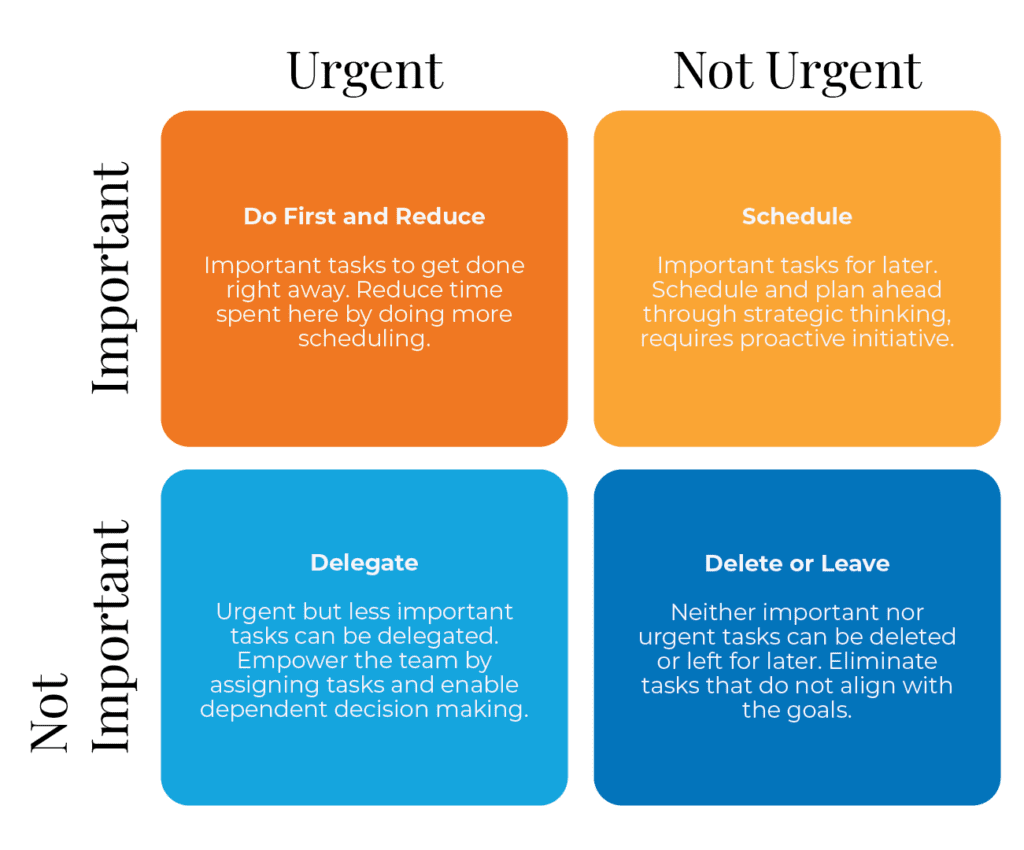In the dynamic world of business, I have found that juggling various tasks, priorities, and deadlines can be overwhelming. I am sure I am not the only one. While you often hear about the importance of time management, I don’t know many people who explore the matter further than just wondering to themselves “I wonder how I can better manage my time?” settling on mere contemplation.
Whenever I encounter a problem like this, I can generally rest assured that there is someone who has developed a strategy to help. After all, with the right strategies in place, you will not only be able to navigate challenges but also learn to thrive in the ever-evolving business landscape.
I would like to share some insights and practical tips that revolve around one of the most powerful tools in my arsenal—the Eisenhower Priority Matrix also known as the Urgent-Important Matrix. It is a time management tool that categorises tasks into four quadrants based on their urgency and importance. Developed by former U.S. President Dwight D. Eisenhower, this matrix has become a cornerstone in the realm of productivity. Anyone else get excited by a matrix?
Urgent tasks need to be dealt with pronto – those immediate action tasks that pop up out of nowhere. They’re the visible issues with consequences if you don’t tackle them. Urgent tasks can’t be avoided, but if you spend all your time playing firefighter, it can lead to a lot of stress and even lead to burnout. Now, the important tasks, that’s the real game-changers that need some planning and thoughtful action. It’s all about the long-term goals and personal values. When you dive into the important matters, you’re not just throwing your time, energy, and attention around like confetti. It’s more about managing these resources wisely. What is important is subjective and depends on your own values and personal goals. Nobody else gets to decide what matters to you.
With these two concepts in mind, let’s delve into the different quadrants.

Quadrant I: Urgent and Important – The Crisis Zone
This quadrant is reserved for tasks that demand immediate attention and action, accompanied by deadlines. These are often firefighting situations that can’t be ignored without consequences. I recall a project where a key client was facing a sudden crisis, and a swift response was essential to prevent long-term damage. By addressing the issue head-on and implementing a targeted intervention, we not only resolved the crisis but also strengthened our client relationship.
Tasks in Quadrant I are unavoidable; even if you manage to avoid procrastination entirely (a bit of an unrealistic expectation in my experience), there will always be external factors beyond your influence. The issue arises when these unforeseen or deadline-driven tasks become the sole focus, overshadowing the pursuit of your essential long-term goals. Dedicating excessive time to Quadrant I tasks can lead to heightened stress, burnout, and a feeling of losing control over your daily activities. It can also deplete your energy and enthusiasm for your work, potentially pushing you towards the mindless escapism of Quadrant IV.
Quadrant II: Not Urgent but Important – The Strategic Zone
In this quadrant lie tasks that contribute to long-term goals and success. Quadrant II is the space for engaging in “deep work” as it provides a sanctuary from immediate distractions. However, because these tasks may lack a specific deadline or conclusion date, it makes it tempting to postpone them in favour of more pressing matters. It is therefore important to hold yourself accountable and invest time in the Strategic Zone to improve overall effectiveness in achieving long-term goals. Examples include: (i) strategising for both long and short-term projects; (ii) routine chores or maintenance projects; (iii) cultivating professional networks and fostering personal relationships; and (iv) acquiring new skills, staying abreast of current research in your field, and participating in conferences and seminars.
Consistent focus on Quadrant II diminishes the frequency of urgent issues arising in Quadrant I. Embracing Quadrant II living allows you to formulate plans for project completion and proactively prevent potential issues. For instance, putting off your car’s routine maintenance is like playing a game of vehicular roulette. You might think you’re avoiding the steep mechanic’s bill, but one day, your car decides to throw a dramatic tantrum on the highway, leaving you stuck and contemplating your life choices.

Quadrant III: Urgent but Not Important – The Deception Zone
Tasks in this quadrant are best described as busy work. They may seem urgent, but they often distract from more critical priorities. These can include unnecessary meetings, emails, or other interruptions. Quadrant III is the realm of the mere urgency effect, where the relentless push to complete tasks, driven by either real or assumed deadlines, leads you into tackling things that don’t really resonate with your personal goals and tend to align more with someone else’s priorities. Lingering too long in this zone can leave you feeling like you’re fulfilling obligations rather than pursuing your own desires.
To remedy this, offload as many Quadrant III tasks as possible. Can you delegate certain tasks to colleagues, freeing up your time for more strategic work? Is it possible to streamline processes or implement tools that automate repetitive and time-consuming aspects of your job? Are there meetings that could be condensed or made more efficient, saving valuable time? Could outsourcing specific tasks or projects be a viable option for maximising productivity? Are there opportunities for collaboration that could distribute workload more effectively within your team?
The key question to ask is: What aspects of your life can be streamlined or delegated? It is all about eliminating busy work so that you can focus on what really matters. I once faced a situation where an urgent client request for a minor adjustment in a presentation threatened to divert my focus from a crucial upcoming presentation. Recognising the deceptive nature of the request, I delegated the presentation task to a team member and maintained my focus on the presentation preparation, ensuring its success.
Quadrant IV: Not Urgent and Not Important – The Waste Zone
Tasks in this quadrant are neither urgent nor important, making them the lowest priority. They also tend to take over large chunks of time. It’s essential to minimise time spent on activities that don’t contribute to professional or personal growth. In my journey, I’ve tried to identify and eliminate time-wasting habits. While we each have our own ways of wasting time, most are universal like watching Netflix and scrolling through social media (finding yourself on your brother’s best-friends uncle’s dog’s Instagram page wondering how you got there). Quadrant IV is where you dive into excess and quick fixes, but it tends to leave you with that unsatisfied feeling when you realise hours have disappeared!
One can also find oneself in this Waste Zone during work, for instance, constantly checking emails or attending non-essential meetings. Implementing stricter boundaries on these activities has allowed me to reclaim valuable time for more impactful endeavours.
I’m not saying we shouldn’t have periods of calm and enjoy some leisure time. Like with most things in life, the trick is balance. But here’s the thing – if you’re not intentional about how you unwind, your downtime can end up sapping your energy, passion, and creativity.

Now that we’ve delved into the Eisenhower Priority Matrix, let’s explore some personal strategies that have proven effective in my day-to-day.
1. Prioritise with Purpose:
- Establishing a consistent morning routine sets a positive tone for the day. Begin each day by identifying and prioritising tasks using the Eisenhower Priority Matrix.
- Focus on Quadrant II – the Strategy Zone to proactively address important tasks before they become urgent.
- Implement the “Eat That Frog” Principle and tackle your most challenging or important task first thing in the morning.
2. Time Blocking:
- Allocate specific time blocks for different types of tasks. This minimises the mental energy required to switch between different types of activities, enhancing overall efficiency.
- Dedicate uninterrupted periods for deep work on important projects.
- Utilise the Pomodoro Technique and break your work into focused intervals (typically 25 minutes), followed by a short break. This technique can enhance concentration and prevent burnout by promoting regular breaks.
- Employ the 2-Minute Rule: if a task takes less than two minutes to complete, do it immediately. This helps clear small items from your to-do list quickly, preventing them from accumulating and becoming overwhelming.
- Avoid overcommitting and learn to say no or set boundaries when necessary to protect your time and focus.
3. Learn to Delegate:
- Recognise tasks that can be delegated to team members or support staff.
- Empower others to take ownership, fostering a collaborative and efficient work environment.
4. Set Realistic Goals:
- Establish achievable short-term and long-term goals.
- Break down larger projects into manageable tasks to avoid feeling overwhelmed.
- Leverage productivity tools and apps to streamline tasks, manage projects, and set reminders.
5. Regularly Review and Adjust:
- Periodically assess and adjust your priorities based on evolving circumstances.
- Be open to learning from experiences and refining your gement approach. Invest time in learning about new tools, methodologies, and time management techniques.
Embarking on a journey from chaos to control and discovering the power of intentional time management has allowed me to command my day with purpose, make strategic choices, and see my productivity soar.
Mastering time management is not just a skill; it’s a strategic imperative. The Eisenhower Priority Matrix serves as a compass to guide us through the complex landscape of tasks and priorities. By sharing my personal experiences and strategies, I hope to inspire you to embrace a proactive and intentional approach to time management. We’ve all heard the phrase “Time is money”, so why do we continue to choose to waste it? The way I look at it is… investments reap interest, so putting a bit of time away upfront to strategise your tasks and objectives every day will ensure you reap the benefits in the future.
It is important to remember that effective time management is not a one-size-fits-all solution. It’s a personalised journey of continuous improvement and adaptation. As you navigate through your professional journey, may these insights and strategies empower you to optimise your time, enhance productivity, and contribute to your success.
With all of this in mind, you are probably thinking “So, what now?”
As an experiment, gauge your current position on the matrix, and kick off by keeping tabs on your time and tasks. After accumulating a few days’ worth of data, take a moment to sit down and categorise your tasks into quadrants by pondering these questions:
- Was this urgent for me?
- Was this important to me?
Always bear in mind that you’re assessing these criteria based on your own aspirations, not someone else’s. Once your tasks are neatly organised into their respective quadrants, take a peek at where your time is currently flowing. Are you happy with your Urgent-Important matrix?
Your journey from chaos to control starts with these insights; embrace it, own it, and thrive.

